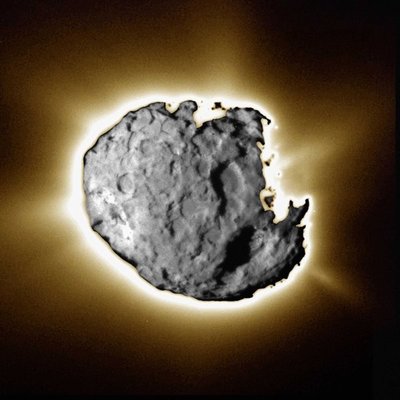June 17, 2004
A celestial surprise: Comet Wild 2 unlike any other body in solar system
When the Stardust spacecraft met up with comet Wild 2 in January, scientists fully expected pictures to show a big chunk of rock and ice liberally coated with dark dust, obscuring any interesting features.
Instead, they got images rich with broad mesas, craters, pinnacles and canyons with flat floors and sheer walls, all sharply defined and covering the comet’s surface area of about 20 square miles.
“It’s completely unexpected. We were expecting the surface to look more like it was covered with pulverized charcoal,” said Donald Brownlee, a University of Washington astronomy professor and Stardust’s principal investigator.
Stardust, launched by the National Aeronautics and Space Administration in 1999, is returning to Earth with thousands of particles less than a millimeter in size. They were captured during a flyby Jan. 2 as they streamed from Wild 2 at more than 13,000 miles per hour. Several particles larger than bullets actually struck the spacecraft, Brownlee said.
A capsule carrying the sample is to parachute into the Utah desert in January 2006.
In the meantime, it appears the scientists will have more than they expected to keep them busy, in part from 72 pictures of Wild 2’s nucleus taken by the spacecraft’s navigation camera.
Brownlee is the lead author of a paper in the June 18 edition of Science describing Wild 2’s surface as seen in those photographs, taken as Stardust flew less than 150 miles from the comet’s nucleus. Three other papers in the same edition describe jets visible on the comet’s surface that spew material into space at supersonic speeds; the unexpectedly chaotic distribution of dust particles coming off the comet; and a mass spectrometer analysis of the particles’ composition. Brownlee is a co-author of two of those papers.
The paper discussing the photographs describes two different kinds of craters, probably created when other space bodies slammed into the comet nucleus. One type has a rounded central pit and a surrounding terrain that is rough, presumably because material was ejected during the impact. The other type has a flat floor and nearly vertical cliffs. The scientists have assigned names to some of the craters, including two called Right Foot and Left Foot because of their uncanny resemblance to footprints.
But unlike craters you might find on Earth, the moon or other solar system bodies, these are remarkably free of powder or other debris that fell back to the surface after the impact, making it possible to clearly see their features.
One reason there is so little debris appears to be the makeup of the nucleus, Brownlee said. He likened it to a clump of hard dirt that can absorb impact but is brittle so it loses some material when it is hit. Another reason is that there’s not much to bring the powder back to the surface once it has been ejected from a crater.
“There’s almost no gravity at the surface,” he said. “If you were standing on the nucleus, you could jump into orbit.”
Brownlee’s co-authors are also co-investigators for the Stardust mission. They are Friedrich Horz, Michael Zolensky and Zdenek Sekanina of NASA’s Johnson Space Center in Houston; Ray Newburn, Thomas Duxbury and Peter Tsou of the Jet Propulsion Laboratory in Pasadena, Calif.; Scott Sandford of the NASA Ames Research Center near Sunnyvale, Calif.; Martha Hanner of the University of Massachusetts; Benton Clark of Lockheed Martin Astronautics in Denver; Simon Green of the Planetary and Space Sciences Research Institute in England; and Jochen Kissel of the Max-Planck Institut für Aeronomie in Germany.
The authors speculate that the comet’s surface has so many discernable features because most of it either absorbed impacts from other space bodies or vented water or other volatile substances into space via the comet’s jets.
They also suggest that Wild (pronounced vilt) 2 has probably lost only about three feet of its surface since a close encounter with Jupiter in 1974 moved it closer to the sun, where greater heat means the comet loses more of its mass. Before 1974 the comet’s orbit carried it far beyond Jupiter, and long ago it likely was in the Kuiper Belt, a ring of sub-planet-sized objects beyond the orbit of Pluto.
Many of the features visible on the comet’s surface probably are billions of years old, perhaps from around the time that life first arose on Earth, Brownlee said. If that is the case, the nucleus almost certainly carries evidence of how the solar system came together in the first place, evidence the scientists hope is contained in the return capsule en route to Earth.
The images also show that a popular notion of comet structure — that it essentially is a pile of rubble packed loosely and traveling through space — does not apply to Wild 2, Brownlee said.
“We’re sure this is a rigid material because it can support cliffs and spires,” he said.
Stardust is a collaboration of the UW, NASA and its Jet Propulsion Laboratory, managed by the California Institute of Technology, and Lockheed Martin Space Systems. Other key members are The Boeing Co., Germany’s Max-Planck-Institut für extraterrestrische Physik, NASA Ames Research Center and the University of Chicago.
Brownlee suspects the comet will give the collaborating scientists still more surprises, and will help them unlock the secrets to Wild 2’s beginnings, and Earth’s, before it finally meets its end, probably sometime in the distant future.
“Its fate is that it will hit the sun or a planet, or it will get thrown out of the solar system, if it doesn’t disintegrate first,” he said.
###
For more information, contact Brownlee at (206) 543-8575 or brownlee@astro.washington.edu
The Stardust Web site is at http://stardust.jpl.nasa.gov



